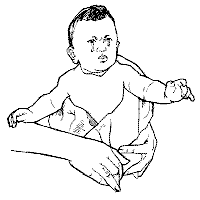How Some Childhood Infectious Diseases Are Spread
| Method
of Transmission |
Direct
Contact
with infected person's skin or body fluid |
Respiratory
Transmission
(passing from the lungs, throat, or nose of one person to another
person through the air) |
Fecal-Oral
Transmission
(touching feces or objects contaminated with feces then touching your
mouth) |
Blood
Transmission |
Chickenpox*
Cold Sores
Conjunctivitis
Head Lice
Impetigo
Ringworm
Scabies |
Chickenpox*
Common Cold
Diphtheria
Fifth Disease
Bacterial meningitis*
Hand-Foot-Mouth Disease
Impetigo
Influenza*
Measles*
Mumps*
Pertussis*
Pneumonia
Rubella* |
Campylobacter**
E. Coli O157**
Enterovirus
Giardia
Hand-Foot-Mouth Disease
Hepatitis A*
Infectious Diarrhea
Pinworms
Polio*
Salmonella**
Shigella |
Cytomegalovirus
Hepatitis B*
Hepatitis C
HIV Infection |
*Vaccines
are available for preventing these diseases.
**Often transmitted from infected animals through foods or direct
contact. |
As the table
shows,
- Skin infections
may be spread by touching fluid from another person’s infected
sores.
- Respiratory-tract
infections with symptoms such as coughs, sneezes, and runny noses are
spread mainly through exposure to fluids present in or expelled from
another person’s mouth and throat (saliva or mucus), often when
an uninfected person touches these discharges with their hands and then
touches their mouth, eyes, or nose.
- Intestinal
tract infections, including some types of diarrhea, usually are spread
through exposure to germs in the feces. Many of the germs discussed
in this manual are spread through what is known as “fecal-oral”
transmission. This means that germs leave the body of the infected person
in the feces (poop) and enter the body of another person through the
mouth. In most situations, this happens when objects (including toys,
fingers, or hands) which have become contaminated with undetectable
amounts of feces are placed in the mouth. Fecal-oral transmission can
also occur if food or water is contaminated with undetectable amounts
of human or animal feces, and then is eaten or drunk. Improperly prepared
foods made from animals (for example, meat, milk, and eggs) are often
the source of infection with Campylobacter, E.coli O157, and
Salmonella.

- Some infections,
like infection with Salmonella and Campylobacter, may
be spread through direct exposure to infected animals.
- Blood
infections are spread when blood (and sometimes other body fluids) from
a person with an infection gets into the bloodstream of an uninfected
person. This can happen when infected blood or body fluid enters the
body of an uninfected person through cuts or openings in the skin; the
mucous membrane that lines body cavities, such as the nose and eye;
or directly into the bloodstream, as with a needle.
- Some diseases,
such as chickenpox, impetigo, and hand-foot-and mouth disease, can have
more than one transmission route. For example, they may be spread through
air or by direct contact with the infectious germ.
|